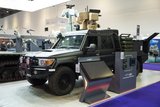Raytheon's One Force successfully demonstrated
Raytheon’s One Force communications solution has been successfully utilised during a recent US Army exercise at Fort Benning, Ga. According to a Raytheon company statement the system simultaneously transmitted data, voice and video over 3G and military tactical hand-held tactical radios for the first time without any interruptions in service.
According to Raytheon during the US Army Expeditionary Warrior Experiment (AEWE) soldiers were able to ‘see everyone's position in the group, talk over the networks, exchange data messages and view live streaming video from an unmanned aircraft system (UAS). They were also able to collaborate on their devices using a feature called ‘white boarding,’ which is similar to the tool that diagrams replays on televised football games. Pictures drawn on one smart phone or tablet were immediately communicated to all other devices in the network, even in the dense foliage at Fort Benning’.
The experiment was an important milestone for Raytheon’s tactical communications in providing a robust and reliable network with their high-speed Mobile Ad-Hoc Interoperable Network GATEway (MAINGATE). According to the company, with more than eight years of development and testing in many tactical environments, including Afghanistan, MAINGATE serves as a tactical bridge among groups, allowing soldiers to communicate, even when separated by trees and other obstacles. MAINGATE uses the Next Generation Mobile Ad-Hoc Network (MANET) Waveform, which has proven to be highly effective and efficient in challenging radio frequency conditions. OCEUS Networks provided the 3G mobile base stations that were integrated with MAINGATE for the experiment.
More from Digital Battlespace
-
![Babcock nears first customer for Nomad AI translation tool]()
Babcock nears first customer for Nomad AI translation tool
Nomad can provide militaries with real-time intelligence, saving critical time on the battlefield.
-
![AUSA 2025: Israel’s Asio Technologies to supply hundreds of improved Taurus tactical systems]()
AUSA 2025: Israel’s Asio Technologies to supply hundreds of improved Taurus tactical systems
Taurus operates alongside the Israel Defense Forces’ Orion system which supports mission management across tens of thousands of manoeuvring forces, from squad leaders to battalion commanders.
-
![AUSA 2025: Kopin pushes micro-LED plans as China moves faster]()
AUSA 2025: Kopin pushes micro-LED plans as China moves faster
The plan for the new displays follows fresh investment in Kopin’s European facilities by Theon and an order for head-up displays in fielded aircraft, with funding from the US Department of Defense.
-
![AUSA 2025: Persistent Systems to complete its largest order by year’s end]()
AUSA 2025: Persistent Systems to complete its largest order by year’s end
Persistent Systems received its largest ever single order for its MPU5 devices and other systems earlier this month and has already delivered the 50 units to the US Army’s 4th Infantry Division.
-
![Aselsan brings in dozens of companies and systems under the Steel Dome umbrella]()
Aselsan brings in dozens of companies and systems under the Steel Dome umbrella
Turkey has joined the family of countries attempting to establish a multilayered air defence system with government approval in August 2024 for the effort landed by Aselsan. Dubbed Steel Dome, the programme joins Israel’s Iron Dome, the US Golden Dome, India’s Mission Sudarshan Chakra and South Korea’s low-altitude missile defence system.
-
![DSEI 2025: MARSS unveils new agnostic multidomain C4 system]()
DSEI 2025: MARSS unveils new agnostic multidomain C4 system
MARSS’ NiDAR system has been deployed using sensors from static platforms to provide detection and protection for static sights, such as critical infrastructure, ports and military bases.




























